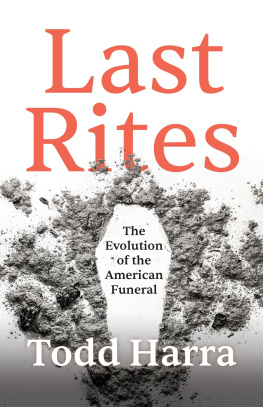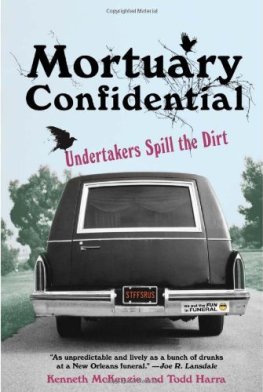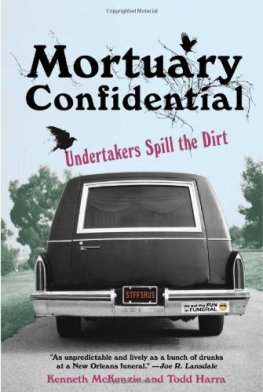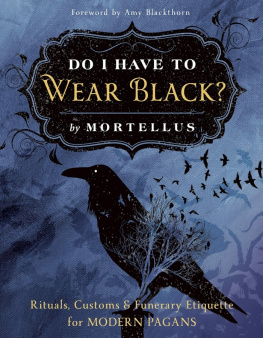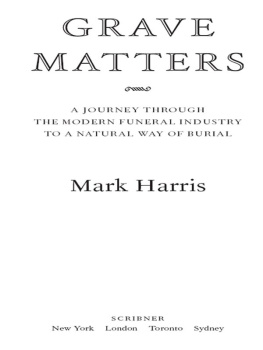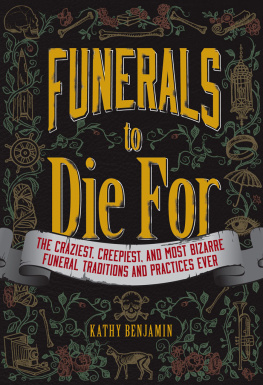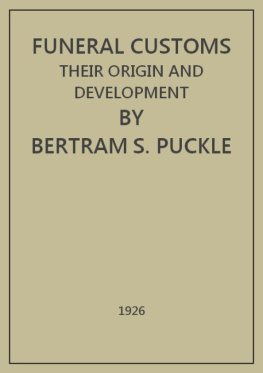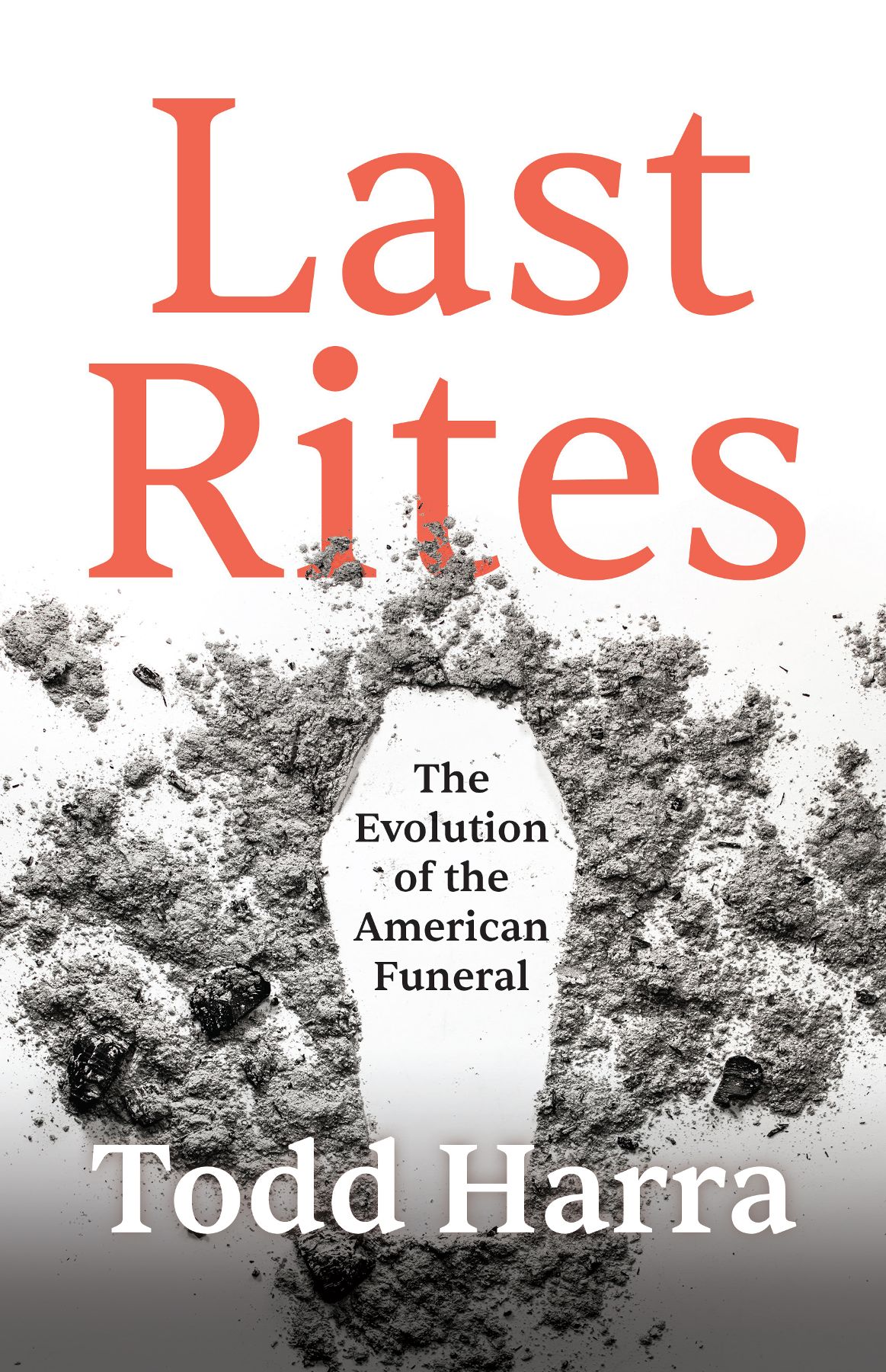
Praise for Last Rites
A treasure trove of morbid intrigue. Never has a work of nonfiction read more like a thriller novel. Leaving no gruesome detail unexplained, Last Rites is the way history books should always be written.
Southern Calls
The Journal of the Funeral Profession
For anyone who ever wonders why funerals are the way they are, this book weaves history and modern funeral rites in a way that compares historical norms with current funeral rituals. A must-read.
Brian Waters
host of Undertaking: The Podcast
To other histories of funeral customs in North America, we can add this richly researched and annotated text by Todd Harra, for whom funeralsboth the idea of the things and the things themselvesare worthy of a lifes work and serious scrutiny. Humanity is never so manifest as when a human dies; what we do about mortality separates us from other species. Last Rites is for mortals and mortuary sorts, the reverend clergy, and reverential humanists. And Harra is the most reliable kind of witness: a practitioner, scholar, and storyteller.
Thomas Lynch
author of The Depositions and Bone Rosary
Last Rites
Also by Todd Harra
Nonfiction
Mortuary Confidential: Undertakers Spill the Dirt
Over Our Dead Bodies: Undertakers Lift the Lid
Fiction
Grave Matters
Patient Zero
Last Rites
The Evolution of the American Funeral
Todd Harra

Sounds True
Boulder, CO 80306
2022 Todd Harra
Sounds True is a trademark of Sounds True, Inc.
All rights reserved. No part of this book may be used or reproduced in any manner without written permission from the author and publisher.
Published 2022
Book design by Linsey Dodaro
Excerpt from Death and Burial in the Roman World by J. M. C. Toynbee 1971. Reprinted by kind permission of The Johns Hopkins University Press (Baltimore) and Thames & Hudson Ltd. (London).
Sumi, Geoffrey S. Impersonating the Dead: Mimes at Roman Funerals. American Journal of Philology 123:4 (2002), 560, 573, 576, 578. 2002 Johns Hopkins University Press. Reprinted with permission of Johns Hopkins University Press.
BK06230
Library of Congress Cataloging-in-Publication Data
Names: Harra, Todd, author.
Title: Last rites : the evolution of the American funeral / Todd Harra.
Description: Boulder, CO : Sounds True, 2022. | Includes bibliographical references and index.
Identifiers: LCCN 2021039101 (print) | LCCN 2021039102 (ebook) | ISBN 9781683648055 (Hardcover) | ISBN 9781683648062 (eBook)
Subjects: LCSH: Funeral rites and ceremoniesUnited StatesHistory.
Classification: LCC GT3203 .H37 2022 (print) | LCC GT3203 (ebook) | DDC 393/.930973dc23/eng/20220223
LC record available at https://lccn.loc.gov/2021039101
LC ebook record available at https://lccn.loc.gov/2021039102
For Melissa, who puts up with the undertaker lifestyle.
To the dead... in our own beloved country, we owe, not only the foundations of the great fabric of our liberties, but those lessons of wisdom, justice, and moderation, upon the observance of which alone can depend its stability.
Charles Fraser
Dedication of Magnolia Cemetery, Charleston, South Carolina
November 19, 1850
Contents
An Introduction
W e die. Were embalmed. Were waked. Theres public notification. The community comes together for a service, then were burned or buried. This is the American funeral.
Our death rituals, like all things American, are unique to the culture, but they share connective tissue with the far corners of the globe dating to antiquity. These often strange rituals, and by extension the men and women plying the dark arts, are almost as mysterious as death itself. Last Rites lifts the curtain and offers a glimpse of why we bury our dead the way we do.
The American funeral rite coalesced in a single moment involving a marble-sized piece of metal.
Ever since the first permanent settlement was established at Jamestown, the American death rite was a simple, austere event, borrowing heavily from English burial traditions. The remains were washed and dressed at home. A local cabinetmaker furnished a custom-made coffin, and the remains were carried by hand and immediately buried in the towns commons or on family land. The family and townsfolk gathered for the repast, and the funeral service was delivered after the burial.
Overnight, the tectonic plates shifted.
A seventeen-gram lump of Britannia metalabout the weight of an AAA batteryforever altered the American funeral experience, at least once John Wilkes Booth loaded it into his derringer and fired it into President Lincolns head.
Lincolns death was merely the catalyst for brewing changes coming on the heels of the Civil Wars turmoil. A nation was in intense mourning, grieving its 650,000 dead sons. But there were other, external pressures being put on the old funeral traditions. Population centers were exploding, America was building its infrastructure, and the Industrial Revolutionput into overdrive by the recent warwas luring Americans off their farms and into cities and factories. Americans were more mobile, goods were becoming cheaper and more plentiful, and Americans were outsourcing the care of their sick... and their dead.
However, the thing that set America on a unique trajectory, casting off the vestiges of the old ways from across the Atlantic, was embalming. During the war, embalming surgeons had been practicing the new sanitary science of embalming, an archaic anatomical technique imported from Europe, thrust into the spotlight by necessityfor shipment purposesand legitimized by Lincoln himself. Lincoln ordered the embalming of his good friend and former law clerk Colonel Elmer E. Ellsworth after he was killed during the war, and was so astounded by the results that when his beloved son Willie died of typhoid, he had him embalmed as well. This progression of events made it such that when Lincoln was martyred, it was only natural that Mary Todd Lincoln had him prepared the same way, thus thrusting this obscure wartime technology into the face of a nation.
An astounding 880,000 Americans cast their eyes upon the martyred president, a feat that hasnt been surpassed in a single untelevised funeral since, thanks to the newly adopted sanitary science of embalming. It was nothing short of a miracle, and it set the stage for the American funeral.
In the next three and a half decades leading up to the end of the century, the pieces fell into place. Factories started churning out ready-made caskets, replacing the old tradesman undertaker making coffins in his workshop; hearses morphed into specialized vehicles; extravagant floral displays became de rigueur; and the fear of body snatching led to the advent of the burial vault. In a sleepy little town in western Pennsylvania, a man built a personal crematorium. And Americans shifted the care of their sick and dead from the home to institutional settings such as hospitals and funeral parlors. From this vacuum stepped the funeral director, a man (almost always a man in those times) versed in all the necessaries needed to properly get someone in the ground.
One such man, James White, was a cabinetmaker in rural Milford, Delaware. My great-great-great-grandfather.
Next page
